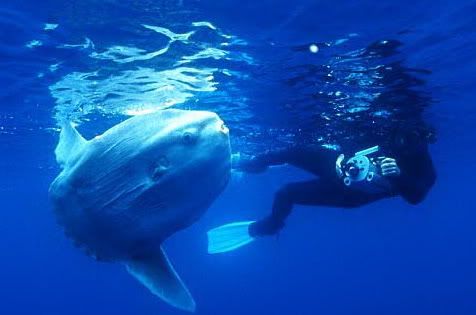The ocean sunfish may empathize with us. This fish is commonly known as the mola, a name that comes from the Latin word meaning 'millstone' in reference to its round shape. It is called poison lune (moon fish) in France, schimmernderkopf (swimming head) in Germany, and manbou (flipping wheel fish) in japan. It is one of three members belonging to the Molidae family: Mola mola, the common mola; Masturus lanceolatus, the sharp-tailed mola; and Ranzania laevis, the slender mola.
 In Indonesia, Mola mola can be found in the waters around Nusa Penida, one of the three 'sister' islands located off the eastern coast of Bali. They 'arrive' in the area around June, specifically in Crystal Bay and Blue Corner, and usually stay till October. They use these few months to sunbathe like many seasonal holidaymakers hence their name.
In Indonesia, Mola mola can be found in the waters around Nusa Penida, one of the three 'sister' islands located off the eastern coast of Bali. They 'arrive' in the area around June, specifically in Crystal Bay and Blue Corner, and usually stay till October. They use these few months to sunbathe like many seasonal holidaymakers hence their name.Spending most of their time in the upper 40-50m of the ocean, the mola restore their body temperature with the heat from the sun by floating horizontally to soak up the rays. In the afternoons, the fish dive repeatedly to 100-300m and occasionally to depths of over 600m and in the evenings, the rest near the surface.
They also use this time to bathe, as in cleaning their bodies. Amazingly, the mola can host up to forty different parasites on its skin; for this reason it is wise for us not to touch it unless you want a sample of marine parasites.
 As it sunbathes near the ocean surface, the mola acts as a free buffet for seabirds and cleaner fish. So if we meet a mola, it is a good idea not to disturb them during their food-supplying program. Besides, in touching the fish we will remove the outer layer of mucus that protects it against infection.
As it sunbathes near the ocean surface, the mola acts as a free buffet for seabirds and cleaner fish. So if we meet a mola, it is a good idea not to disturb them during their food-supplying program. Besides, in touching the fish we will remove the outer layer of mucus that protects it against infection.Spotting a mola during a diving trip is a wondrous, joyous experience. Despite our excitement, however, it is important to be courteous to the fish.
During their sunbathing 'holiday', our awe-filled gaze will not disturb them as long as we maintain a minimum distance of 3m when the fish is at a cleaning station, and a minimum distance of 10m the fish is considering an approach to the reef or appears unsettled. It is also best that we do not make any unnecessary noice, so as not to disturb the rhythm of marine music.
Coming accross the mola is a lucky meeting that may inspire a Kodak moment but don't use flash, because it disturb them. Be careful no to block their escape route, and swim ahead of or next to the fish so as not to startle their friendly cleaner fish with bubbles from our breathing apparatus.
The sunfish live on a diet of jellyfish, supplemented with zooplankton, squid, fish, larvae, crustaceans, algae, eelgrass, and various seabed invertebrates. With such items on their menu, the fish increases its weight about 60 million times as they grow from larva to adult. A mola at California's Monterey Bay Aquarium apparently gained 346kg in only 14 months! Obviously, the sunfish do not have a problem with obesity.
A mola reaches its full size in 10 years, attaining a vertical span of over 3m from it dorsal to anal fins and weighing about 1000kg, and enjoy an underwater lifespan of an average 20 years.
These unique ships with their parasitic passengers also carry a secret. While it is known that female sunfish lay their eggs in the water for the males to fertilize externally, no one has ever witnessed the mola spawn in the wild. A few of the mola's spawning areas have been identified, but it is believed that there are many more areas yet to be discovered.
No comments:
Post a Comment